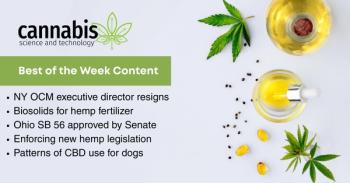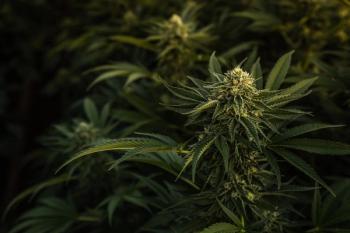
Cannabis Science and Technology
- May 2023
- Volume 4
- Issue 6
- Pages: 18-21
Innovations in Extraction Targeting Specific Wellness Goals

Searching for purer, minor cannabinoids is the goal of new extraction research as extractors dig deeper into the diversity of the plant.
There has been a movement underway now gaining traction within cannabis extractors to make cannabis edibles more functional in their effect and therefore broader in their appeal. Call them designer cannabis products, if you will, or just call them next generation cannabis products with a wellness purpose.
Shaping that reality are edible makers who have found better ways to extract various minor cannabinoid compounds to make a more terpene-heavy product favored by consumers, that comes with a controllable level of psychoactive components (or none at all), which consumers believe they can trust. These edibles are targeted as go-to sleep aids, anxiety aids, anti-inflammation assistance, or other comfort and wellness aids that are not about just getting as high as possible—which was the goal of the first generation of cannabis edibles back in 2014.
Extractions support a clearer market direction now, in both the recreational and medical side. But there’s more to its rise in popularity. The increasing number of countries decriminalizing cannabis has become one of the key trends in the cannabis-infused edible products market during 2021–2025 (1). The global edibles market is expected to reach $25 billion by 2025, with 75% of that growth coming from North America.
This installment of “Tech Innovations” discusses new ideas in extraction that are beginning to find out more about the plant and its capabilities. Some topics covered include extractions that help adjust bioavailability; cleaner extractions that are safer for the consumers; and how cannabis extraction methods are embracing some of the old-school extraction technologies used for decades, even as the cannabis industry begins to take the lead in the technological evolution of extraction.
“We’re starting to see evolution of all these traditional techniques, like CO2, ethanol, hydrocarbon,” said Jessie Kater, senior vice president, innovation, research, and development at Curaleaf (2). “And as good as they’ve gotten, there are pros and cons to each of those techniques. There is no universally best technique. You have to choose which one meets your business needs, or your product needs, the best.”
Vince Harkiewicz, CEO and co-founder of Grownetics, a farm and grow automated system developer, is seeing a push-back against the huge wave of isolates, he mentioned, as he watched the development of the industry in Colorado (3). “It was fascinating to see the innovation go towards how to do fractional distillation and isolate out all these terpenes, all these secondary metabolites,” he said.
The push-back came when it was determined that if you isolate all those terpenes out there is actually very little evidence and very little research that’s been done showing that isolated compounds have the same effect as the whole plant, or as even more complex compounds from the whole plant. “So, there’s this huge shift towards live rosin, fresh frozen products, to get that whole plant experience to the consumer. And that’s where the connoisseur has also gone,” Harkiewicz said.
Edibles Innovations Making Inroads
Curaleaf, headquartered in New York, makes edibles with nanoparticles. “People describe a much more social, less anxious experience with these products,” explained Kater. “So, people will be able to go to the bar and socialize with friends with a nano gummy product.”
Curaleaf recently released its JAMS (4) edible product line, made using nano and liposomal technology. JAMS includes a food grade nano emulsification technology that’s completely all-natural, Kater said. “It’s taking those fat-soluble cannabinoids, surrounding them with kind of a more water soluble outer shell. So, you get more of the cannabinoid intact and able to be delivered to the target receptor sites where we want them to have their efficacy, ” said Kater.
With nanotechnology, Kater explained that they’re seeing initial onset as fast as 10 to 15 min, and peak onset around the 30 min mark. “It’s a powderized formulation,” he said. “So, we call it a pre-liposomal, meaning the cannabinoids are not liposomal in the product itself. But when it hits the aqueous saliva in your mouth, it assembles into liposomes.”
The product, offered in wide range of dosage options and promoted for cannabis consumers just starting out with edibles, features an improved bioavailability. “Typically, you wouldn’t see technologies like this being deployed—this self-assembling-when-it-hits-saliva,” he added.
Curaleaf primarily and historically has done CO2 extraction, along with some ethanol and hydrocarbon extraction, Kater stated. “CO2 has really kind of been our national workhorse. I feel good about CO2 from a safety perspective because of the fact that CO2 is a big component of the air we breathe. We use food grade CO2 (5), where when you release it from pressure, it dissipates so there’s no residual CO2 in the product,” said Kater.
CO2 often isn’t thought of as a solvent because it’s a gas, he said. “But CO2, in the way we use it, is a solvent.”
One new innovative extraction device of note is the Towers Highrise press (6), a scalable, solventless rosin press that has just been released. “It’s substantially different to anything else,” Harkiewicz mentioned. “This is the sort of innovation we’re seeing in the extraction solvents side, which is these mechanical kind of systems that haven’t existed yet.” The unit costs about $60,000, he added.
Duncan Mackie, the Director of Pharmacology & Experimental Therapeutics at MedPharm Holdings (7), commented that MedPharm’s extraction methods are done using cryo-ethanol. “That’s a real big one,” Mackie said. “Throughput-wise, it’s allowing us to extract large amounts of cannabis now, doing everything at -40. We’re keeping everything really cold so that we’re not pulling through fats and waxes.”
They still use supercritical CO2 to get full high terpene-rich mixtures at MedPharm. “We’re investigating terpenes, minor cannabinoids, flavonoids, and just about any kind of compound that we can isolate from that plant, or extract from the plant,” he said.
MedPharm is looking at these compounds, and their activity at the cannabinoid 1 and cannabinoid 2 receptors, as well as orphan receptors. “So, there’s GPR55 (a novel cannabinoid receptor [8]) and a couple other orphan receptors that we’re starting to see really cool pharmacology,” Duncan said. “It’s a really exciting time to be in cannabis as a scientist with my background. It’s a rarity that you get to work in an area that should have been explored 100 years ago.”
Antiflammatory Medicines Are the New Calling for Cannabis
Cannabis has developed great compounds for anti-inflammatory treatments. One study (9) found that future approaches for improved usage of cannabis “demand the development, transformation and formulation of full-spectrum cannabis extracts into active plant ingredients to achieve higher effectivity,” and that cannabis components can be combined with other pharmaceutical drugs to reduce inflammation.
Mackie said that MedPharm is looking at the inflammatory condition in the context of neurodegeneration in Alzheimer’s, Parkinson’s, Huntington’s, traumatic brain injuries, and concussions, such as chronic traumatic encephalopathy (CTE) with the National Football League (NFL). CTE has been found in 99% of NFL players, according to a research at Boston University (10). “It doesn’t have to be tetrahydrocannabinol (THC). It doesn’t have to have that euphoric side effect,” Mackie said. “We’ve selected for that compound over all these years of selective breeding. But these minor kind of compounds, we don’t know much about them.”
There’s tetrahydrocannabivarin (THCV) anecdotally used as an appetite suppressant as well as cannabinol (CBN), anecdotally discussed as well, with a little more research getting behind it, looking at sleep disorders (11). “You’re starting to see people take interest in these minor cannabinoids,” Mackie said. “I’ve been interested from the beginning. It was like that’s where the medical value is going to come from.”
The body’s way of healing itself is through inflammation. “When the inflammation goes awry in the brain, you have to figure out a way to temper it down,” said Mackie.
COVID-19 is one newer example of inflammation. According to the National Institutes of Health, (NIH) prolonged inflammation after COVID-19 infections (12) have been shown to cause permanent damage to lungs and kidneys. “There might even be a place for cannabinoids for treatment there,” Mackie added. “The plant itself is quite amazing. And the medical value is through the roof.”
To isolate the minor cannabinoids, Mackie uses high performance liquid chromatography (HPLC) (13) in their laboratory, where they can take a mixture of 120 cannabinoids at very different percentages and isolate them at 99% pure, which is pharmaceutical grade purity. “We have the ability to actually isolate super high purity minor cannabinoids, and can work to address questions such as what does this combination in this ratio do to a neuron, or to a microglia (the immune cells of the brain), or to a muscle cell in a cell culture system?
“It’s actually getting that mechanistic work and that’s the basis of how we need to be going about it from a scientific standpoint, in the drug discovery lab,” said Mackie, adding that it’s a complex plant that is going to have poly-pharmacology. “You’re going to have to have components that are going to go together because they almost need to go together. Because that’s how the plant did it.”
Live Rosin versus Live Resin
Kater has been doing a lot of live rosin work, which is different from live resin. “When I think about live resin, I think about fresh frozen being extracted with a hydrocarbon solvent, which is a derivative of petrochemical things like propane and butane,” he said. “When done at cold temperatures, and with a fresh frozen material, you get a really terpene rich extract, which consumers really like.”
The trade-off is a petrochemical derivative is used to do that extraction as your solvent-based extraction. Live rosin, on the other hand, is truly solventless, Kater stated. “In this case, we’re taking fresh frozen material, and just using a physical process.”
With this process, they are freezing the trichomes in an ice water bath, and then just using physical means to agitate and break those THC and terpene-containing trichomes off the plant. Through a heating process, they convert THC and terpene-containing trichomes off the plant and convert them into an oil or a concentrate. “It’s a little bit more labor intensive,” he said. “It’s a little bit less of a yield than a solvent extraction. But you’re really getting the purest expression of just natural cannabis trichomes containing the cannabinoids and terpenes with no interference of any solvents or rigorous chemical processing at all.”
He thinks using this process is the closest that an extractor can get into concentrated vapable experience to the actual flower itself. “It may be even preferred to some extent because you’re getting rid of some of the plant components, like carbohydrates, that really aren’t made for inhalation,” said Kater. “I think a big part of the growth we’re seeing in the rosin categories is because people appreciate that full plant flavor taste.”
Kater explained that the company recently filed a provisional patent on an extraction process that uses nothing but water. “It’s different from the rosin process because we’re using water as a solvent. It’s a unique process, because you don’t typically think of cannabinoids as water soluble, because they’re not. But we’ve we found an interesting way to go about making them water soluble and being able to use water as an extraction solvent. So that’s an innovative process that we’re developing. There are others,” he added.
The Consumer Drive
Kater noted that they’ve gone from the days where potency was the only thing that mattered, to where consumers want a broader spectrum of cannabinoids. “Then you get into terpenes, a wide variety of terpenes,” he said. “We want them intact as they are in the plant, not altered, not degraded. That brings out that full flavor. Consumers are really starting to realize that the terpene profile has a massive influence on the type of experience they have with a particular strain, from sedated to silly to a happier experience. That’s really starting to drive the market, particularly on the vape and concentrate side of the market.”
Harkiewicz mentioned that all the innovation right now is happening around the molecular chemistry, and through solventless extraction methods, and the different pressing recipes such as squishing hash through filter bags with a low temperature press. “That is still so young, in such its early days,” he said. “It’s been around for a while, but there hasn’t been a lot of innovation that’s reached the market yet in that space, because we’re dealing with so many new markets still coming online, figuring this all out for the first time.”
He believes that the extraction discussion is really about the craft side of things, because there are not tools to do this sort of extraction at large scale yet. “So, it’s really interesting to see all this innovation happening in the craft market,” Harkiewicz expressed. “A lot of our clients are much larger and are wanting to dip their toes in and wanting to get into solventless. But then not understand that, okay, there are not tools built for that scale in the solventless realm yet.”
If you want a designer cannabis experience, there are still challenges in getting that right. “I think it’s because, first of all, the effect isn’t consistent because depending on your genetic disposition, it is or is not going to affect you in the same way,” he said. “That’s another uniquely challenging side of designer effects.”
Conclusion
There’s so much mystery about the plant on the therapeutic side, Kater said, about what cannabis strain and what cannabinoids and what terpenes are there, and why they should be used for therapeutic application. “That can all be unraveled through understanding the biochemistry of how these cannabinoids and terpenes are interacting with the receptors, and the downstream cascade of signaling that takes place, as well as the pharmacokinetics of these products.”
Extraction to process plants is not new. The technology can be traced back thousands of years (14). In fact, CO2, ethanol, and hydrocarbon extraction have been used in industries long before there was legal cannabis in the US. The cannabis industry and its industry-specific innovation has attracted some of the old school extractors working in soaps, perfumes, and even beer. For example, the focus on terpene production has also been picked up by hops farmers, Harkiewicz said. “That’s all they care about as well, like massive terpene production, especially with the trend for all these very, very fragrant IPAs,” he observed. “So, there are companies who are doing hop extracts, which seems like they took a note from the cannabis industry providing crop extracts to the brewers now as well.”
Mackie commented that he is starting to see people really latch on to the well-known analytical chemistry methodologies and physical chemistry methodologies. “The knowledge just wasn’t there before. And there was more a lack of the expertise in the field.”
Now he’s coming across a lot more people with more advanced degrees in the cannabis space, who have the scientific knowledge, and have been trained. “And now we’re finally applying (that scientific process) to this plant which is really exciting,” he said.
“Stoners are pretty innovative,” Mackie said. “You give them the tools, they generally run with it. Extraction-wise, we’ve gotten really advanced over the last decade. Now it’s the biomass. It’s really trying to find those unique cultivars that give you the cannabinoid variants at a high enough concentration that we can extract them and then actually do the pharmacology on them.”
References
- Technavio. Cannabis-infused Edible Products Market Size to Grow by USD 25.27 Billion: Find Future Trends, Analysis, and Insights: Technavio
https://www.prnewswire.com/news-releases/cannabis-infused-edible-products-market-size-to-grow-by-usd-25-27-billion--find-future-trends-analysis-and-insights--technavio-301561762.html . - Jessie Kater
https://ir.curaleaf.com/management-team?item=68 . - The Future of Farming is Open
https://grownetics.co/about/ . - Curaleaf Holdings Inc. Curaleaf Expands Brand Portfolio with Launch of JAMS™ Cannabis-infused Edibles
https://www.prnewswire.com/news-releases/curaleaf-expands-brand-portfolio-with-launch-of-jams-cannabis-infused-edibles-301781463.html . - Co2 Gas Supplier: Co2 Gas Near Me
https://www.airproducts.com/gases/carbon-dioxide?utm_feeditemid=&utm_device=c&utm_term=food+grade+co2&utm_source=google&utm_medium=ppc&utm_campaign=North-CO2&hsa_cam=12689956503&hsa_grp=127986210680&hsa_mt=p&hsa_src=g&hsa_ad=537149132299&hsa_acc=1445747373&hsa_net=adwords&hsa_kw=food+grade+co2&hsa_tgt=kwd-300898220303&hsa_ver=3&gclid=CjwKCAjwrJ-hBhB7EiwAuyBVXUyPvWr1F9MgZZcdzbefWpasrRVO31DFIxVnKxK_iGtP1Wizvhx-mhoC-AUQAvD_BwE . https://towershighrise.com/ .- Duncan Mackie, Ph.d. - Director of Pharmacology ... - Linkedin
https://www.linkedin.com/in/duncan-mackie-ph-d-3bb1892b . - Ryberg, E.; Larsson, N.; Sjögren, S.; Hjorth, S.; Hermansson, N.O.; Leonova, J.; Elebring, T.; Nilsson, K.; Drmota, T.; Greasley, P.J. The Orphan Receptor GPR55 is A Novel Cannabinoid Receptor
https://pubmed.ncbi.nlm.nih.gov/17876302/ . - Anil, S. M.; Peeri, H.; Koltai, H. Medical Cannabis Activity Against Inflammation: Active Compounds and Modes of Action
https://www.ncbi.nlm.nih.gov/pmc/articles/PMC9124761/ . - Category: NFL
https://www.bu.edu/cte/category/nfl/ . - CBN for Sleep
https://www.sleepfoundation.org/sleep-aids/cbn-for-sleep . - Long Covid Symptoms Linked to Inflammation
https://www.nih.gov/news-events/nih-research-matters/long-covid-symptoms-linked-inflammation . - High Performance Liquid Chromatography
https://chembam.com/definitions/hplc /. - U.S. Forest Service
https://www.fs.usda.gov/wildflowers/ethnobotany/medicinal/index.shtml .
About the Columnist
David Hodes has written for many cannabis publications, and organized or moderated sessions at national and international cannabis trade shows. He was voted the 2018 Journalist of the Year by Americans for Safe Access, the world’s largest medical cannabis advocacy organization.
How to Cite this Article:
Hodes, D., Innovations in Extraction Targeting Specific Wellness Goals, Cannabis Science and Technology, 2023, 6(4), 18-21.
Articles in this issue
over 2 years ago
Chromatographic Theory, Part V: Chromatographic Resolutionover 2 years ago
The Importance of Air Quality in Cannabis CultivationNewsletter
Unlock the latest breakthroughs in cannabis science—subscribe now to get expert insights, research, and industry updates delivered to your inbox.




